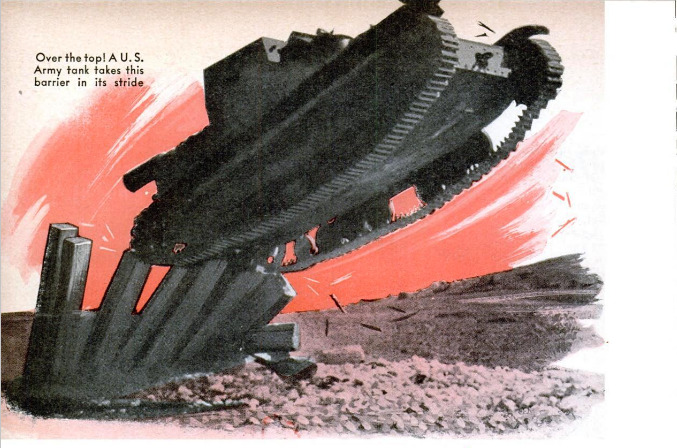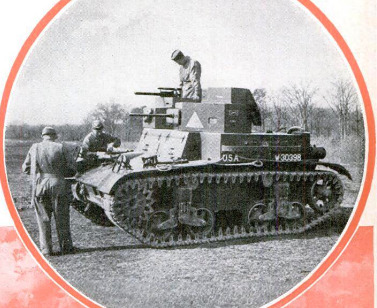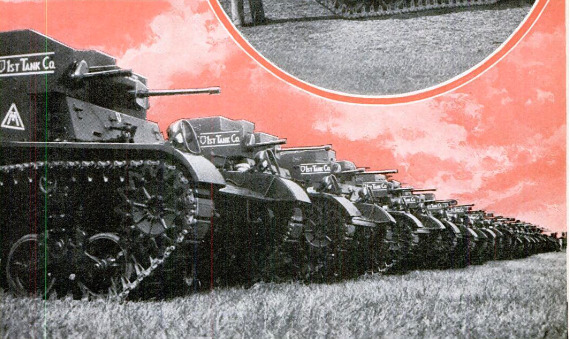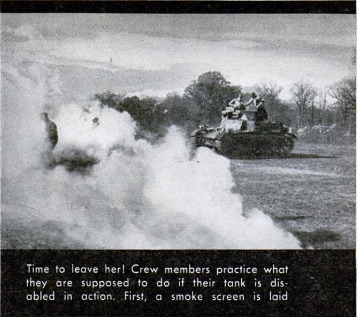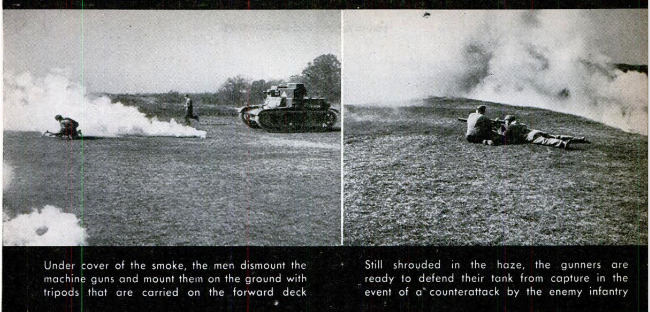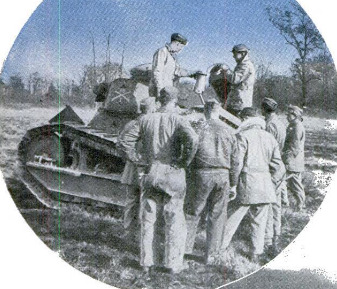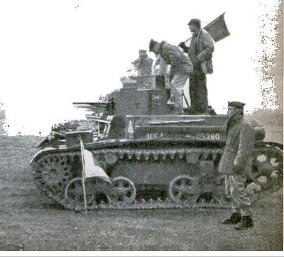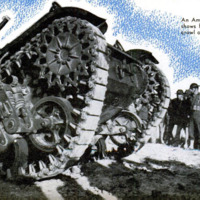-
Title (Dublin Core)
-
Uncle Sam groom his hell buggies
-
Article Title and/or Image Caption (Dublin Core)
-
Uncle Sam groom his hell buggies
-
extracted text (Extract Text)
-
ONE cold morning this win-
ter I stood in a big, open
field at Fort Hoyle, Md.,
talking about tanks with Lieut.-Col. B. G.
Chynoweth, who commands the First Bat-
talion of the G6th Infantry, the Regular
Army light-tank regiment which traces its
history back to the American Tank Brigades
‘which fought in Belgium and in the Argonne
two decades ago. Near us a long line of
tanks stood waiting; 600 yards away, where
scrub and brown underbrush edged the field,
men were working over a bullet-scarred,
paintless old Renault which, crewless, was
serving as a moving target for its offspring.
“Take a ride in one of the tanks,” the
Colonel invited. “That's the best way to get
an idea of what they're like.”
‘When I lowered myself through the turret
port—a tanker needs to be a fair sort of
acrobat —into the right-hand front seat, the
sergeant who was driving gave me a friend-
ly grin. The inside of a tank with its engine
running isn't the best place in the world for
verbal amenities. There wasn't any room to
spare, but the steel walls were painted
white, and with the driving and turret ports
open the interior was light.
‘The sergeant manipulated one of his steer-
ing levers after the other and nudged his
eleven-ton steed around sharply. We began
to move forward, picking up speed quickly.
The motion over the fairly rough field was
noticeable but not unpleasant—a sort of
easy pitching, like the motion of a small
boat when a ground swell is running. I
thought that we were going about twenty-
five miles an hour, but later was told that
we had been doing a good thirty-five. When
we reached the end of the field the sergeant
swept his tank around in a wide turn. Then
we roared back up the field, turned sharply,
and nosed into our berth at one end of the
firing line as neatly as a sport roadster
could have done it.
Of course, riding in a tank over an open
field isn't anything like riding in a tank over
the sort of terrain on which tank battles are
likely to be fought—rough cround made
rougher by being well cut up with trenches
and shell holes and by being strewn thickly
with obstructions of various unpleasant
Kinds. And the interior of a tank with its
ports open isn't anything like the inside of a
Tullcrewed tank Wilh Tis Torts closed for
BOTLON=W IIIS TON Wo (now lyon.
experience told me, can be very hot
when bullets are spanging on its
steel sides. Tankers are
trained and hardened to
“take it” over the roughest
ground under simulated bat-
tle conditions.
Colonel Chynoweth asked
me if I'd like to try a few
bursts at the old Renault,
which had been headed 50
that it would run across the
field in front of the lined-up
tanks. I moved back to the rear seat, which
is somewhat higher than the front seat, and
one of the officers showed me how to wedge
myself in behind the 30 caliber turret
machine gun. You fold your right leg under
you and kneel on the seat, brace your left
Toot solidly against the steel floor plate, and
press your back hard against the back of the
turret. That settles you as solid as a rock,
bringing your shoulder snugly against the
gun butt ‘and your right eye close to the
sight tube alongside the barrel. Horizontal
and vertical hair lines divide the sight's
eyepiece into four quadrants, and the gun is
mounted so that only slight pressure is
needed to change its elevation or to traverse
its muzzle across a wide field of fire.
While I was getting acquainted with my
gun, the sergeant had switched off
his engine and was getting set to
do a little shooting with the .50
caliber machine gun in the other
turret. “Get the nose of the tank
in the upper right quadrant and
you'll sock her,” he advised. Look-
ing through the narrow eye slit
above the gun I saw that the old
Renault had been started and was
rumbling briskly across the field.
It seemed a lot smaller than it
had a minute earlier. When I
squinted through the sight the
tank looked even smaller. At 600
yards it blended into the drab
scrub behind it, and smoke from
underbrush which had been set
afite by tracer bullets on an
earlier run didn't make the target
any clearer.
I got the tank's nose in the
upper right quadrant, and pressed
the trigger. The gun went fat-
tat-tat, and the fiery tracer bullets
told me that I was shooting high and to the
right. I swung the muzzle down and to the
left—and couldn't find the tank! All I could
see through the sight was a vague cloud of
brown dust kicked up by bullets from the
twenty-odd machine guns which were firing.
I aimed at the dust cloud, but I don't think
1 hit anything in it.
When I had fired all my shots T watched
through the eye slit. Near the end of its
run the tank came clear of the dust cloud
and some gunner got squarely on his target.
You could see the tracer bullets bouncing off
its armor into the tree tops, like red balls
out of a Roman candle. The cease-firing
whistles sounded, but that old Renault kept
right on going. The long wire, connected
with its engine switch, which it had been
trailing behind had been cut by a bullet.
The tank crashed into the underbrush and
wallowed slowly along until a fair-sized
tree stopped it.
The Colonel took me down to have a look
at it. Nothing interests tankers
more than seeing what bullets
can and can't do to their tanks.
The ancient Renault's armor
was scratched and dented by several hun-
dred machine-gun bullets, but not one of
them had gone through it.
My close-up of tanks at work taught me
three important things about them: that
they can move fast, that they aren't easy to
hit, and that if their armor is moderately
heavy they aren't very likely to be hurt by
machine-gun or rifle fire.
‘While the U. S. Army can't compare with
European mechanized forces in number of
tanks, American officers are confident that
we are away ahead of them in quality—that
in the M2A1 model tank now being built we
nave the best light tank in the world. Driven
by a powerful airplane-type, air-cooled en-
gine, it has a road speed of above thirty-five
miles an hour and a correspondingly high
cross-country speed. Its armor is heavier
and its tracks longer than the present
standard light tank, and in addition to four
machine guns it carries a 37-millimeter
cannon. The tracks, driven by
sprockets and rolling over four
bogie wheels on each side which
support the weight of the vehicle,
are made of a long-wearing, heat-
resisting rubber composition set
in steel blocks. Its engine, trans-
mission, drive, and tracks all are
considered superior to those of
any foreign tank.
The medium tank now being
built
also is of advanced design. It is heavier,
more heavily armored, and a more powerful
all-around fighting weapon than the light
tank, but it isn't nearly so fast on the road,
and its use is restricted to districts where
the bridges can bear its increased weight.
Our army has no very heavy tanks—the So-
called land battleships built for special
purposes by some European armies,
The tank is the offense’s answer to the
defensive power of the machine gun. The
defense has found several answers to the
offensive power of the tank. Most spectacu-
lar of them is the quick-firing antitank gun.
The model now being produced for our
Army is of 37-millimeter caliber and its
two-pound shells pierce an inch and a half
of modern armor at 1,500 yards. Other
armies have similar weapons.
Attacking infantry advances at the speed
of about two miles an hour. On average
ground, tanks come under direct fire from
antitank guns at a range of about 1,000
yards. So if the tanks limit their speed to
the speed of the infantry, they are under
direct fire of weapons capable of destroying
them for seventeen minutes. If they ad-
vance at their top cross-country speed of
about thirty miles an hour—which wouldn't
often be possible in war—the danger period
is reduced to a little over a minute. The
light tanks now being built carry a 37-
millimeter gun of their own for use against
machine-gun emplacements and antitank
guns, and perhaps against enemy tanks.
At long range, a gun on the ground has an
advantage over a tank; at short range, a
tank has an advantage over a gun on the
ground. The quicker tanks can get to close
quarters, the more likely they are to win. No
matter how fast they are, some of them will
be knocked out by artillery or antitank-gun
fire. Tankers are trained to act fast when
it is time to “leave her’—to get out on the
ground with their machine guns and pro-
tect their disabled tank against capture.
The American idea is for the tanks to go
in at the best speed possible, and to reach
and cruise over their objective while in-
fantry supports them with its fire and the
artillery concentrates on the enemy's anti-
tank guns. After the tanks have destroyed
the enemy machine-gun nests the infantry
will be able to filter forward with slight
losses. Bullheaded hammering against im-
pregnable defenses has no place in the
‘American conception of tank tactics. A tank
attack should be a swift, surprising, and
hard-hitting blow where it will hurt.
-
Contributor (Dublin Core)
-
Arthur Grahame (article writer)
-
Language (Dublin Core)
-
eng
-
Date Issued (Dublin Core)
-
1940-02
-
pages (Bibliographic Ontology)
-
76-79, 231
-
Rights (Dublin Core)
-
Public domain
-
Archived by (Dublin Core)
-
Sami Akbiyik
-
Marco Bortolami (editor)
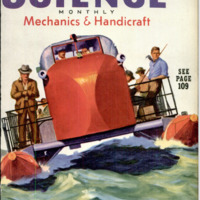 Popular Science Monthly, v. 136, n. 4, 1940
Popular Science Monthly, v. 136, n. 4, 1940

